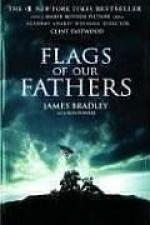|
This section contains 678 words (approx. 2 pages at 400 words per page) |

|
Flags of Our Fathers Summary & Study Guide Description
Flags of Our Fathers Summary & Study Guide includes comprehensive information and analysis to help you understand the book. This study guide contains the following sections:
This detailed literature summary also contains Topics for Discussion and a Free Quiz on Flags of Our Fathers by James Bradley (author).
"Flags of Our Fathers" by James Bradley tells the true story of the men who were the flag raisers in the iconic image taken during the horrific battle of Iwo Jima during the Pacific phase of World War II. The account begins with an explanation by James Bradley, author and son of one of the flag raisers, of what compelled him to pursue the story of these men. Bradley and his seven siblings knew that their father's experiences in World War II, the flag raising and its aftermath, were subjects that his father did not want to discuss. After his father's death, James decided to find out what caused his father's reaction, how the six flag raisers came together on Iwo Jima and the aftermath of the war and the event on these men.
The six flag raisers were all young men, ranging in age from eighteen to twenty-four. As World War II raged, the young men and their families knew the writing was on the wall. They may soon be part of it. When the Japanese attacked Pearl Harbor, their fates were sealed. Many of the men joined the Marines to avoid being drafted by the Army. Jack Bradley was urged by his father to join the Navy so he could avoid combat. Little did father or son know that by joining the Navy, Jack would be heading for the bloodiest battle in U.S. history.
Jack, who had been working as a medic in a military hospital in Oakland, was transferred to San Diego where he was attached to a Marine unit. The unit, E Company which was ironically referred to as Easy Company, began a rigorous training program that began in San Diego and was finally completed a year later on a small atoll in the Pacific called Tarawa. The six flag raisers were part of a huge armada of more than 800 ships heading for a historic confrontation that would take place on Island X, which was later revealed as Iwo Jima. Conquering that island was thought to be strategic in driving back Japanese aggression.
The battle on Iwo Jima lasted 36 bloody days with the Americans finally emerging victorious. However, the losses were stunning—Americans suffered some 26,000 casualties. Early in the battle, the Marines had taken Suribachi, a volcanic mountain on the southern tip of the island. A discarded pipe was used as a flag pole and an American flag was located on one of the ships. The first flag raising was with a smaller flag and different soldiers. A larger flag was attached to the make-shift pole and hoisted by six different marines and was captured by Joe Rosenthal, an imbedded AP photographer. Rosenthal was certain the photo would be blurred or lack good quality. But when the film was finally processed, an AP editor said it all when he proclaimed, "This is one for history." The reaction in America was overwhelming—the photo represented hope and victory even though the actual battle on Iwo Jima was far from over.
Three flag raisers were killed in battle shortly after the photo was taken. Jack Bradley was seriously injured and dispatched to a military hospital. The other two men battled on uninjured until the island was conquered. The surviving flag raisers were recruited by President Truman to head the war bond drive. Bradley never felt comfortable with the "hero" label he received. To him, the true heroes were the ones that didn't get to come home. Ira Hayes rejected the hero image as well but experienced many personal problems after returning from active duty. The other surviving flag raiser, Rene, enjoyed the limelight but felt he was never given a chance for success after returning as a hero from the war.
Rosenthal won the Pulitzer Prize for the photo and Felix de Weldon created the famous sculpture of the flag raising that resides at Arlington National Cemetery. The image will remain an inspiration to victory and hope but represents one of the most horrific battles in U.S. history.
Read more from the Study Guide
|
This section contains 678 words (approx. 2 pages at 400 words per page) |

|



